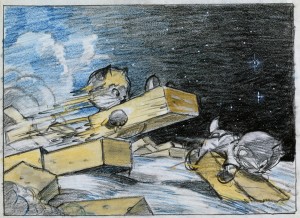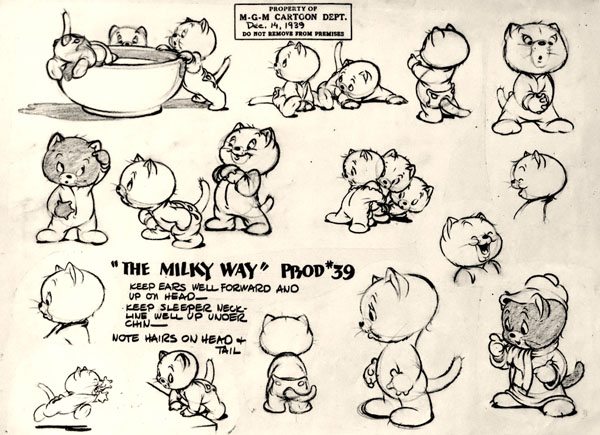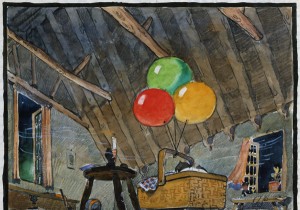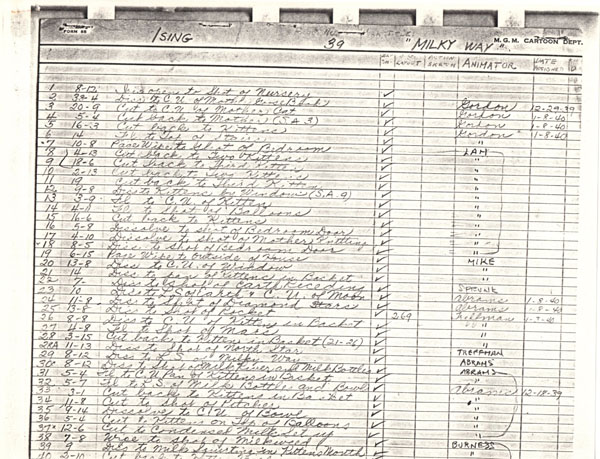
This week’s breakdown profiles another Oscar-winning cartoon by Rudy Ising!
 Through the 1930s, Walt Disney’s status became more revered in animation. He received multiple Academy Awards for the Silly Symphonies, including one special entry, Ferdinand the Bull (1938). After the success of Snow White and the Seven Dwarfs, Disney sought higher ambitions in feature-length animated films, and thus ceased production on the acclaimed Silly Symphonies by 1939. No short subjects from the studio were selected for Oscar candidacy, so other studios previously snubbed by Walt’s triumphs were finally given a merited advantage.
Through the 1930s, Walt Disney’s status became more revered in animation. He received multiple Academy Awards for the Silly Symphonies, including one special entry, Ferdinand the Bull (1938). After the success of Snow White and the Seven Dwarfs, Disney sought higher ambitions in feature-length animated films, and thus ceased production on the acclaimed Silly Symphonies by 1939. No short subjects from the studio were selected for Oscar candidacy, so other studios previously snubbed by Walt’s triumphs were finally given a merited advantage.
The Milky Way, directed by Rudy Ising, became the first non-Disney cartoon to receive the honor. The two other nominees, MGM’s Puss Gets the Boot and Tex Avery’s A Wild Hare, which marked the origin of Tom and Jerry and crystallization of Bugs Bunny, represented an impetuous approach to animation, but the Academy still favored a captivating spectacle in the Disney fashion. (Incidentally, Walter Lantz’s Knock Knock, the debut of Woody Woodpecker, was screened by voters but hadn’t received a nomination.) Ising’s partner, Hugh Harman, built his post-Disney career at Schlesinger’s and MGM around competition against Walt. Ising didn’t share the same contempt, yet his cartoons for the latter studio displayed charm and warmth that matched their competition.

Ising assigned his animators to entitled sequences for The Milky Way. George Gordon’s “cutesy” style starts and ends the cartoon. Mike Lah animates the little kittens (designed by Bob Allen) dreaming about the Milky Way, finding their means of conveyance and floating up into the stratosphere.
Ray Abrams draws the kittens more rounded and softer in his scenes, where they reach their destination and dive into their newly found Grade-A treat. David Treffman handles various lunar-based gags (the streamlined comet train, the planet Mars’ shooting stars, the North Star and the Dipper “constellations”), and the kittens in peril in the butter-enclosed milk dam.
 Pete Burness handles the kittens with the “milk weed” and their discovery of milk contained in gas pumps. Carl Urbano animates the milk geysers, and the rumbling effect that occurs when its liquid is consumed by one kitten. It’s difficult to interpret the artist credited for the shot of the Earth receding in scene 22, which is re-used in the film’s climax to illustrate the vast distance between galaxy and terra firma.
Pete Burness handles the kittens with the “milk weed” and their discovery of milk contained in gas pumps. Carl Urbano animates the milk geysers, and the rumbling effect that occurs when its liquid is consumed by one kitten. It’s difficult to interpret the artist credited for the shot of the Earth receding in scene 22, which is re-used in the film’s climax to illustrate the vast distance between galaxy and terra firma.
Production phases for several cartoons, including The Milky Way, were announced by September 1939. Animation was assigned by December 1939 and January 1940, as indicated on the draft. By May, Scott Bradley completed the musical score. A couple of weeks before its June 22 release, MGM coordinated with the National Dairy Council, promoting and advertising Milky Way with milk bottle tops, window cards for grocery stores, streamers and billboards to coincide with National Milk Month.

Enjoy the sparkling color restoration on today’s breakdown video!



(Thanks to Jerry Beck, Michael Barrier and Yowp for their help.)


 DEVON BAXTER is a film restoration artist, video editor, and animation researcher/writer currently residing in Pennsylvania. He also hosts a
DEVON BAXTER is a film restoration artist, video editor, and animation researcher/writer currently residing in Pennsylvania. He also hosts a 




















































































You really get the crystallization of the MGM house ‘style’ right about this time, in the character designs that would carry (in slightly modified form) all the way through Hanna-Barbera’s Tom & Jerry series and even paired down in some cases to the basic designs for some of H-B’s initial TV cartoons (an angrier, more devious version of Bob Allen’s kittens would pretty much show up in “Triplet Trouble” a dozen years after this short was released).
The cartoon itself (as other have noted) is pretty much the feline version of Ising’s “LIttle Buck Cheeser” from three years earlier, but fulfilled the Academy’s needs for what they wanted in an Oscar-winning cartoon, which was pretty much the same thing they had been voting for over most of the past decade. It’s probably a little better and Ising’s original, but in hindsight, you can see how the voters missed the boat when its competition was arguably the two most important non-Disney short cartoons Hollywood ever made.
Dairy council tie-in, huh? This would have been nothing but a 7-minute milk commercial if it weren’t for the punchline. I liked this, but, doesn’t advertising films not qualify for Oscar nomination? Maybe if it was licenced to the dairy council and many dairies then it would have disqualified…………
Like The Sunshine Makers which and I quote “This Entertainment was brought to you by Borden” Borden was and still is one of the major Dairy manufactures in the US.
It was just cross-promotion, the sort of thing the studios did A LOT. There was no specific brand advertised in the short, so it was okay.
It’s no different than Popeye cartoons “advertising” and being cross-promoted with spinach growers and canneries.
If it’s Borden, it’s got to be good!
oh my dear God! A film I’ve never seen. How drop-dead gorgeous!! And beaucoup special effects. I adore it. Thank YOU for jump-starting my Wdnsdy so wonderfully!!!
Is this print on the Academy Award Winners’ set? Or is it an even newer color restoration?
Yes, it is on the Academy Awards set. However, many other WB and MGM did not make it to the set. Sorta off-topic, but in addition to Popeye The Sailor Meets Sindbad The Sailor (1936) and Superman (1941), Fleischer Studios received two more nominations for Educated Fish (1937) and Hunky And Spunky (1938), both from the Color Classics series. However, those two are now owned by Paramount (technically, Paramount owns the negatives; as for the cartoons, they are in public domain).
I read on Wikipedia that some geyser scenes in this cartoon were cut from theaters and television. Did the networks feel that the geyser scenes suggested subliminal references?
Wouldn’t be surprised if they were cut. They sort of represent a sexual reference…
I’m kinda surprised at anyone who hasn’t seen this cartoon before. I can recall it being in heavy rotation during our EARLY BIRD CARTOON SHOW weekday mornings and I love this thing. Can’t always say why I like ’em but classic MGM cartoons are all right to me…and, yup, this falls into that category of great cat cartoons. You can always pair this one off with Warner Brothers’ “FAGEN’S FRESHMEN”; in fact, wouldn’t you say that little Wilber Ambrose Scats in the Warners cartoon looks like one of the kittens in this cartoon? I also like attempts at the big budget animation studios to imagine space exploration, and this cartoon and its predecessor, the amazing “LITTLE BUCK CHEEZER” did an amazing job; I only wish I’d seen both on the big screen in full color. Did Bernice Hansen do all three kitten voices?
CAN YOU DO The Yankee Doodle Mouse BREAKDOWN?
First time I’ve seen this cartoon, and it’s a visual delight with some nice creative space and milk gags. The different animators’ styles can be distinguished (is that a good thing or a bad thing?) with Gordon and Burness’ work recognisable from their scenes on the early Tom and Jerry cartoons. Michael Lah’s animation looks smoother and more polished than his later work. Looks like Ray Abrams moved between the Harman and Ising units a few times.
I wish they could have come up with a better ending than having them just having dreamed/play-acted the whole thing, though.